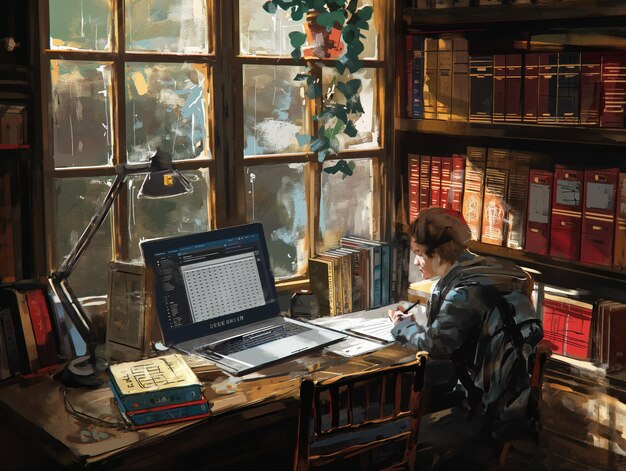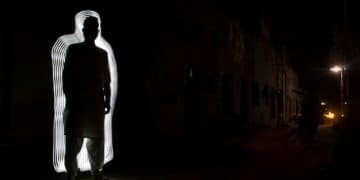Page to Screen: Book-Movie Adaptations in 2025

Critical analysis of book-to-movie adaptations in 2025 reveals a complex dynamic between creative fidelity and commercial viability, exploring what shapes these cinematic interpretations from celebrated literary works.
In the evolving landscape of entertainment, the journey From Page to Screen: A Critical Look at Book-to-Movie Adaptations in 2025 continues to captivate audiences and spark fervent discussions. This article delves into how these narratives transition from printed words to visual spectacles, examining the successes, challenges, and evolving trends shaping the adaptations slated for 2025.
the enduring allure of literary adaptations
The practice of adapting books into films is as old as cinema itself. It speaks to a fundamental human desire to see beloved stories brought to life in a new medium. In 2025, this trend shows no signs of slowing down, with a robust slate of literary works making their way to the big screen or streaming platforms. But why this continuous fascination? Part of the appeal lies in familiarity; audiences are often already invested in the characters and plots of a popular book.
However, the allure extends beyond mere recognition. Adaptations offer a unique opportunity for reinterpretation, allowing new generations of filmmakers to explore classic narratives through contemporary lenses. This process can illuminate hidden depths within the original text or introduce it to an entirely new audience who might not otherwise engage with the written word.
fan expectations versus creative freedom
One of the most significant challenges in book-to-movie adaptations is balancing fan expectations with the creative freedom necessary for cinematic storytelling. Loyal readers often have deeply personal visions of characters, settings, and pivotal scenes. Deviating too much from these mental images can lead to disappointment or even outright rejection from the fanbase.
- Fidelity to text: How closely should an adaptation stick to the original book’s plot, dialogue, and character descriptions?
- Narrative economy: Films require a different pace and structure than books, often necessitating cuts or consolidations of storylines.
- Visual interpretation: Translating descriptive prose into concrete visual elements can be subjective and contentious.
Filmmakers, however, argue that direct transcription rarely makes for good cinema. A film needs to stand on its own as an artistic work, utilizing the strengths of the visual medium. This often involves making difficult choices about what to emphasize, what to condense, and what to omit entirely, leading to a constant tension between two distinct artistic forms.

The debate around creative freedom versus textual fidelity is particularly heated in the age of social media, where fan communities can instantly voice their opinions and exert pressure on studios and directors. This digital feedback loop adds another layer of complexity to the adaptation process, making it harder for filmmakers to make bold interpretive choices without fear of backlash. Ultimately, the most successful adaptations often find a harmonious balance, respecting the source material’s spirit while embracing the unique possibilities of film.
As we look to 2025, it’s clear that this conversation will continue to evolve, with each new adaptation serving as a fresh case study in the delicate art of translating literature to the screen. The best adaptations aren’t just retellings; they are thoughtful re-imaginings that deepen our understanding and appreciation of the source material.
technological advances shaping adaptations
The year 2025 brings with it continued advancements in filmmaking technology, profoundly impacting how books are adapted. From sophisticated CGI that can create entire worlds to advanced virtual production techniques, the tools available to filmmakers are more powerful than ever before. These innovations allow directors to faithfully realize even the most fantastical or historically grand narratives that were once deemed unfilmable due to budget or technical limitations.
For instance, complex magical systems or intricate futuristic cityscapes described vividly in novels can now be rendered with breathtaking realism. This level of visual fidelity can significantly enhance the immersive experience for audiences, bridging the gap between the reader’s imagination and the cinematic portrayal. High frame rates, immersive sound design, and advanced camera technologies also contribute to a richer and more detailed adaptation that can truly transport viewers into the story’s world.
CGI and world-building
The advent of sophisticated Computer-Generated Imagery (CGI) has revolutionized world-building in adaptations. Books with sprawling fantastical realms, alien planets, or meticulously detailed historical settings can now be brought to life with unprecedented scale and detail. This capability is paramount for genres like fantasy and science fiction, where the environment is often as much a character as the protagonists themselves.
- Enchanted forests and mythical creatures: CGI enables the visual translation of magical elements.
- Futuristic cities and interstellar travel: Science fiction worlds can be rendered with intricate detail and realism.
- Historical accuracy: Recreating ancient civilizations or specific historical periods benefits immensely from digital tools.
However, the reliance on CGI also presents a challenge. Overuse or poorly executed effects can detract from the narrative, making the film feel artificial or visually overwhelming. The best use of technology is when it serves the story, enhancing realism or fantasy without drawing undue attention to itself. The goal is to create a believable world, whether it’s grounded in reality or purely imaginative, rather than simply parading digital prowess.
Beyond CGI, advancements in virtual production, as popularized by shows like “The Mandalorian,” allow actors to perform within digitally created environments displayed on massive LED screens. This technology offers a more interactive and immersive experience for the cast, allowing them to react to their surroundings more naturally than against a traditional green screen. It also provides immediate visual feedback for directors, streamlining the post-production process and ensuring a cohesive final product. These technological leaps are crucial in pushing the boundaries of adaptation, making once-impossible literary worlds cinematic realities.
the impact of streaming platforms
Streaming platforms have profoundly reshaped the landscape of book-to-movie adaptations. In 2025, their influence is even more pronounced, offering new opportunities for storytelling and challenging traditional cinematic release models. Unlike theatrical releases, which often demand concise, high-impact narratives, streaming services can support longer-form content, including multi-season series that allow for greater fidelity to complex, expansive literary works.
This shift means that beloved sagas, which might have been condensed into a single film (often to disappointing results), can now be explored with the depth and nuance they deserve. The episodic nature of television series, facilitated by streaming, mirrors the chapter-by-chapter progression of a book more closely, providing ample time for character development, intricate plotlines, and detailed world-building. This format is particularly beneficial for dense fantasy novels or lengthy historical dramas.
expanded narrative possibilities
The flexibility offered by streaming is a boon for adaptations. It allows creators to delve deeper into subplots, explore secondary characters more thoroughly, and maintain the pacing of the original narrative without feeling rushed. This often leads to a more satisfying experience for devoted readers, who can see beloved aspects of their favorite stories preserved and expanded upon.
- Miniseries and limited series: Ideal for standalone novels with extensive detail or specific character arcs.
- Multi-season sagas: Perfect for epic series that require significant screentime to develop.
- Anthology series: Can adapt collections of short stories or separate tales from shared literary universes.
Furthermore, streaming platforms have lower financial barriers to entry for niche or experimental adaptations that might not otherwise secure traditional studio funding. This opens the door for a wider variety of literary genres and authors to reach a global audience, fostering a more diverse storytelling landscape. The ability to directly reach millions of subscribers worldwide also means that successful adaptations can build massive, engaged communities, driving further interest in both the show and the source material.
However, the sheer volume of content on streaming platforms also creates challenges, including increased competition for viewership and the need for standout quality to break through the noise. In 2025, successful adaptations on streaming services will need to balance deep narrative engagement with compelling visuals and strong marketing to capture and retain audience attention in a crowded marketplace.
challenges in adaptation: more than just plot
Translating a book to the screen involves far more than merely re-creating the plot. It’s about capturing the essence of the narrative, the author’s voice, the internal monologues, and the atmosphere that often defines a literary work. These intangible elements are frequently the most challenging aspects for filmmakers to convey, leading to adaptations that, despite following the narrative beats, feel hollow or incomplete to devoted readers.
A novel’s power often lies in its ability to transport the reader into a character’s mind, exploring their thoughts, feelings, and motivations directly. Film, being an external medium, must find visual and auditory equivalents for these internal experiences. This might involve reliance on voiceovers, symbolic imagery, or subtle acting cues, all of which carry the risk of either over-explaining or under-conveying crucial elements.
capturing tone and subtext
One of the significant hurdles is capturing the original book’s tone and subtext. A novel might be satirical, darkly humorous, melancholic, or subtly menacing in its underlying themes. Translating these nuances without explicit narration can be incredibly difficult. Misinterpretations of tone can drastically alter the audience’s reception and understanding of the story.
- Satire: Requires careful visual and narrative choices to maintain its biting commentary.
- Internal conflict: Expressing a character’s inner turmoil without lengthy monologues.
- Ambiguity: Preserving the deliberate uncertainties or open-ended questions posed by the author.

Furthermore, many books contain significant subtext—unspoken meanings, implied relationships, or societal critiques that are woven into the fabric of the narrative. Filmmakers must find creative ways to bring this subtext to the surface cinematically, often through visual metaphors, character interactions, or mise-en-scène. Overly explicit explanations can strip the story of its emotional depth, while too much subtlety might leave audiences confused.
As we observe adaptations in 2025, the success of these films and series will largely hinge on their ability to overcome these complex challenges, moving beyond superficial plot replication to truly encapsulate the heart and soul of the literary source material. The best adaptations are those that understand not just what happens, but why it matters.
the critical lens: evaluating success in 2025
Evaluating the success of book-to-movie adaptations in 2025 requires a multi-faceted critical lens. It’s no longer just about box office receipts or viewership numbers, though those remain important metrics. Success now encompasses elements such as critical reception, fan engagement, and the lasting cultural impact of the adaptation. A truly successful adaptation manages to please both the general audience and the discerning readers of the original work, a rare but achievable feat.
The rise of digital media and instant critiques means that an adaptation’s fate can be sealed within hours of its release. Online forums, social media, and dedicated fan sites become immediate arenas for discussion, praise, and often, strong disapproval. For filmmakers and studios, navigating this opinion landscape is as crucial as the production process itself. Positive word-of-mouth and genuine fan endorsement can propel an adaptation to iconic status, while negative reactions can quickly sink it.
metrics beyond the box office
While financial success is often the primary goal for studios, a more holistic view of adaptation success includes several less tangible, but equally important, metrics. These reflect the deeper impact of the narrative and its translation across mediums.
- Critical acclaim: Reviews from film critics assessing artistic merit and execution.
- Audience engagement: Social media trends, fan theories, and discussions surrounding the adaptation.
- Literary resurgence: A boost in sales or readership of the original book post-adaptation.
- Award recognition: Nominations and wins at prestigious film and television ceremonies.
The cultural impact of an adaptation goes beyond its immediate release. Does it spark new conversations about the themes of the book? Does it introduce new generations to classic literature? Does it inspire spin-offs, merchandise, or further adaptations? These long-term effects signify a truly impactful translation from page to screen, indicating that the story has resonated deeply with a broad audience.
In 2025, the measure of success for adaptations will also increasingly include how well they leverage interactive storytelling elements, particularly in the streaming space. This could mean companion content, augmented reality experiences, or even audience participation in certain narrative choices, further blurring the lines between passive viewing and active engagement, and redefining what a “successful adaptation” truly means.
future trends and adaptation evolution
Looking ahead, the evolution of book-to-movie adaptations in 2025 is poised for continued innovation, driven by technological advancements, changing audience consumption habits, and a growing emphasis on diverse storytelling. We can anticipate more experimental approaches to adaptation, where the traditional boundaries between film, television, and interactive media become increasingly blurred. This could manifest in companion content, immersive VR/AR experiences tied to releases, or even choose-your-own-adventure style narratives inspired by literary source material.
The rising prominence of global content platforms suggests that adaptations will continue to embrace international literature, bringing stories from diverse cultures and languages to a worldwide audience. This not only enriches the narrative landscape but also offers unique perspectives and storytelling styles that might challenge conventional Western cinematic tropes. Such adaptations require careful consideration of cultural nuances to ensure genuine representation.
new formats and mediums
The concept of “screen” is expanding beyond traditional cinemas and television sets. Mobile devices, interactive apps, and virtual reality headsets are becoming increasingly viable platforms for storytelling. This diversification of viewing mediums will influence how adaptations are conceived and produced, potentially leading to more fragmented or personalized narrative experiences.
- Interactive narratives: Stories allowing audience choices to influence plot development.
- Virtual reality experiences: Immersive adaptations that place the viewer directly within the book’s world.
- Podcast and audio drama tie-ins: Expanded universe content in auditory formats.
Furthermore, the drive for authenticity and diverse representation will likely lead to more nuanced casting choices and storytelling perspectives in adaptations. This means moving beyond tokenism to genuinely reflect the multi-faceted nature of the human experience, as often explored in contemporary literature. Authors from underrepresented backgrounds may see their stories adapted with greater frequency and fidelity, contributing to a richer and more inclusive cinematic canon.
In 2025, the most compelling adaptations will not just translate stories, but transform them, pushing the boundaries of narrative possibility while honoring the literary origins that sparked their creation. The future of adaptations promises to be as diverse, dynamic, and engaging as the literary world itself.
| Key Point | Brief Description |
|---|---|
| 📚 Adaptation Challenges | Balancing fan expectations with creative cinematic interpretation is crucial. |
| 🚀 Tech Impact | CGI and virtual production enable complex world-building and visual fidelity. |
| 📺 Streaming Influence | Allows for longer, more faithful series, expanding narrative scope. |
| 🔮 Future Trends | Expect interactive, global, and diverse narratives in various new formats. |
frequently asked questions about book-to-movie adaptations
The primary challenges include translating internal thoughts and complex character development visually, condensing lengthy narratives into a confined runtime, and balancing fidelity to the source material with the creative demands of cinema. Capturing a book’s unique tone and subtext without exposition is also extremely difficult.
Streaming platforms like Netflix and Max have revolutionized adaptations by enabling longer, multi-season series formats. This allows for greater narrative depth, faithful character development, and detailed world-building, which often suits extensive literary works better than single films, reaching global audiences directly.
Advanced technology, especially CGI and virtual production, allows filmmakers to bring highly imaginative or complex literary worlds to life with unprecedented realism. This capability is crucial for fantasy and science fiction genres, enabling the creation of intricate creatures, futuristic cities, and elaborate historical settings previously deemed unfilmable.
Adaptations often disappoint fans when they deviate significantly from beloved plot points, misinterpret character essences, or alter crucial thematic elements. Fans invest deeply in their reading experiences, forming personal visions of the story, and any perceived betrayal of these visions can lead to strong negative reactions, especially online.
Future trends include more interactive storytelling formats, adaptations tailored for new mediums like VR and AR, and a greater emphasis on diverse and global literary sources. There will likely be continued exploration of multi-part cinematic events that maximize narrative scope and detail, enhancing immersive viewing experiences.
conclusion
The journey from page to screen is an intricate dance between preservation and transformation, a process filled with both profound potential and significant pitfalls. In 2025, as technologies advance and audience expectations evolve, filmmakers and content creators continue to push the boundaries of what is possible, striving to deliver adaptations that resonate deeply with both existing fans and new audiences. The enduring popularity of literary adaptations underscores a universal truth: compelling stories, regardless of their original medium, possess the power to captivate, challenge, and inspire, bridging the gap between imagination and cinematic reality.





